change time BUICK CENTURY 2005 Owner's Manual
[x] Cancel search | Manufacturer: BUICK, Model Year: 2005, Model line: CENTURY, Model: BUICK CENTURY 2005Pages: 348, PDF Size: 2.32 MB
Page 2 of 348
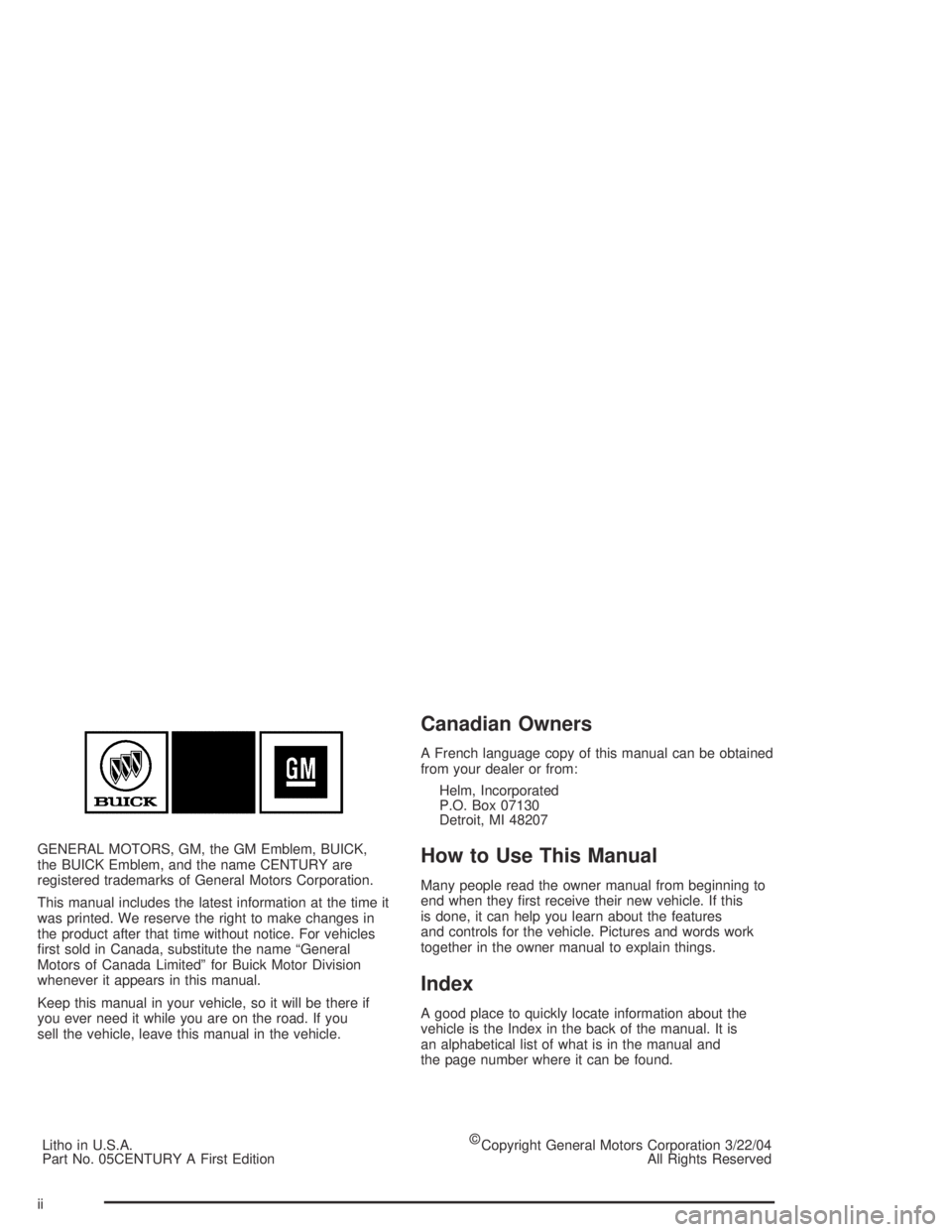
GENERAL MOTORS, GM, the GM Emblem, BUICK,
the BUICK Emblem, and the name CENTURY are
registered trademarks of General Motors Corporation.
This manual includes the latest information at the time it
was printed. We reserve the right to make changes in
the product after that time without notice. For vehicles
�rst sold in Canada, substitute the name “General
Motors of Canada Limited” for Buick Motor Division
whenever it appears in this manual.
Keep this manual in your vehicle, so it will be there if
you ever need it while you are on the road. If you
sell the vehicle, leave this manual in the vehicle.
Litho in U.S.A.
Part No. 05CENTURY A First Edition©
Copyright General Motors Corporation 3/22/04
All Rights Reserved
Canadian Owners
A French language copy of this manual can be obtained
from your dealer or from:
Helm, Incorporated
P.O. Box 07130
Detroit, MI 48207
How to Use This Manual
Many people read the owner manual from beginning to
end when they �rst receive their new vehicle. If this
is done, it can help you learn about the features
and controls for the vehicle. Pictures and words work
together in the owner manual to explain things.
Index
A good place to quickly locate information about the
vehicle is the Index in the back of the manual. It is
an alphabetical list of what is in the manual and
the page number where it can be found.
ii
Page 36 of 348

Infants and Young Children
Everyone in a vehicle needs protection! This includes
infants and all other children. Neither the distance
traveled nor the age and size of the traveler changes
the need, for everyone, to use safety restraints. In fact,
the law in every state in the United States and in
every Canadian province says children up to some age
must be restrained while in a vehicle.
Every time infants and young children ride in vehicles,
they should have the protection provided by appropriate
restraints. Young children should not use the vehicle’s
adult safety belts alone, unless there is no other choice.
Instead, they need to use a child restraint.
{CAUTION:
People should never hold a baby in their arms
while riding in a vehicle. A baby does not
weigh much – until a crash. During a crash a
baby will become so heavy it is not possible to
CAUTION: (Continued)
1-30
Page 70 of 348

Remote Keyless Entry System
Your keyless entry system operates on a radio
frequency subject to Federal Communications
Commission (FCC) Rules and with Industry Canada.
This device complies with Part 15 of the FCC Rules.
Operation is subject to the following two conditions:
1. This device may not cause interference, and
2. This device must accept any interference received,
including interference that may cause undesired
operation of the device.
This device complies with RSS-210 of Industry Canada.
Operation is subject to the following two conditions:
1. This device may not cause interference, and
2. This device must accept any interference received,
including interference that may cause undesired
operation of the device.
Changes or modi�cations to this system by other than
an authorized service facility could void authorization to
use this equipment.At times you may notice a decrease in range. This is
normal for any remote keyless entry system. If the
transmitter does not work or if you have to stand closer
to your vehicle for the transmitter to work, try this:
Check the distance. You may be too far from your
vehicle. You may need to stand closer during
rainy or snowy weather.
Check the location. Other vehicles or objects may
be blocking the signal. Take a few steps to the
left or right, hold the transmitter higher, and
try again.
Check to determine if battery replacement is
necessary. See “Battery Replacement” under
Remote Keyless Entry System Operation on
page 2-5.
If you are still having trouble, see your dealer or a
quali�ed technician for service.
2-4
Page 73 of 348

The vehicle was originally programmed to Mode 3.
The mode may have been changed since then.
To determine the current unlock mode, or to change the
unlock mode, do the following:
1. Close all doors and turn the ignition key to RUN.
2. Press and hold the power door lock switch in
the unlock position.
3. While holding the power door lock switch in the
unlock position, press and release the remote
keyless entry transmitter UNLOCK button.
A series of one to four chimes will sound,
corresponding to the current unlock mode.
4. Press the remote keyless entry transmitter UNLOCK
button to advance to the next unlock mode.
If cycled beyond Mode 4, the vehicle will enter
Mode 1.
5. To set a mode, release the power door unlock
switch after the chime sequence of the desired
mode is heard.Delayed Locking
This feature can be turned on or off. It delays the
locking of the doors for �ve seconds after the LOCK
position on the power door lock, or the LOCK button on
the remote keyless entry transmitter is pressed and
the last door is closed.
If a door is opened before �ve seconds, the delayed
lock is cancelled. When all doors are closed again,
delayed locking begins again.
Three chimes will sound to indicate that this feature is
on. The chime will sound only when the key is not in the
ignition and a door is open.
To cancel delay locking, do any of the following:
Press the unlock portion of the power door
lock switch.
Press the UNLOCK button on the remote keyless
entry transmitter.
Press the LOCK portion of the power door lock
switch a second time.
Press the LOCK button on the remote keyless entry
transmitter a second time.
Insert the ignition key into the ignition.
2-7
Page 75 of 348

Battery Replacement
The battery in the remote keyless entry transmitter
should last about three years.
If the battery is weak the transmitter will not work within
its normal range. It is probably time to change the
battery if you have to be very close to the vehicle before
the transmitter works.
Notice:When replacing the battery, use care not
to touch any of the circuitry. Static from your
body transferred to these surfaces may damage
the transmitter.To replace the battery do the following:
1. Insert a �at object like a thin coin into the slot on
the back of the transmitter and pry apart the front
and back.
2. Remove the old battery, but do not use a metal
object to do this. Make sure the new battery is a
type CR2032 or equivalent, and that the positive (+)
side of the battery is facing down.
3. Snap the front and back of the transmitter together.
4. Resynchronize and test the operation of the
transmitter with the vehicle.
Resynchronization
After the battery has been changed in the remote
keyless transmitter, it will need to be resynchronized.
To do this, press and hold both the LOCK and UNLOCK
buttons on the remote keyless entry transmitter until
one horn chirp is heard.
2-9
Page 85 of 348
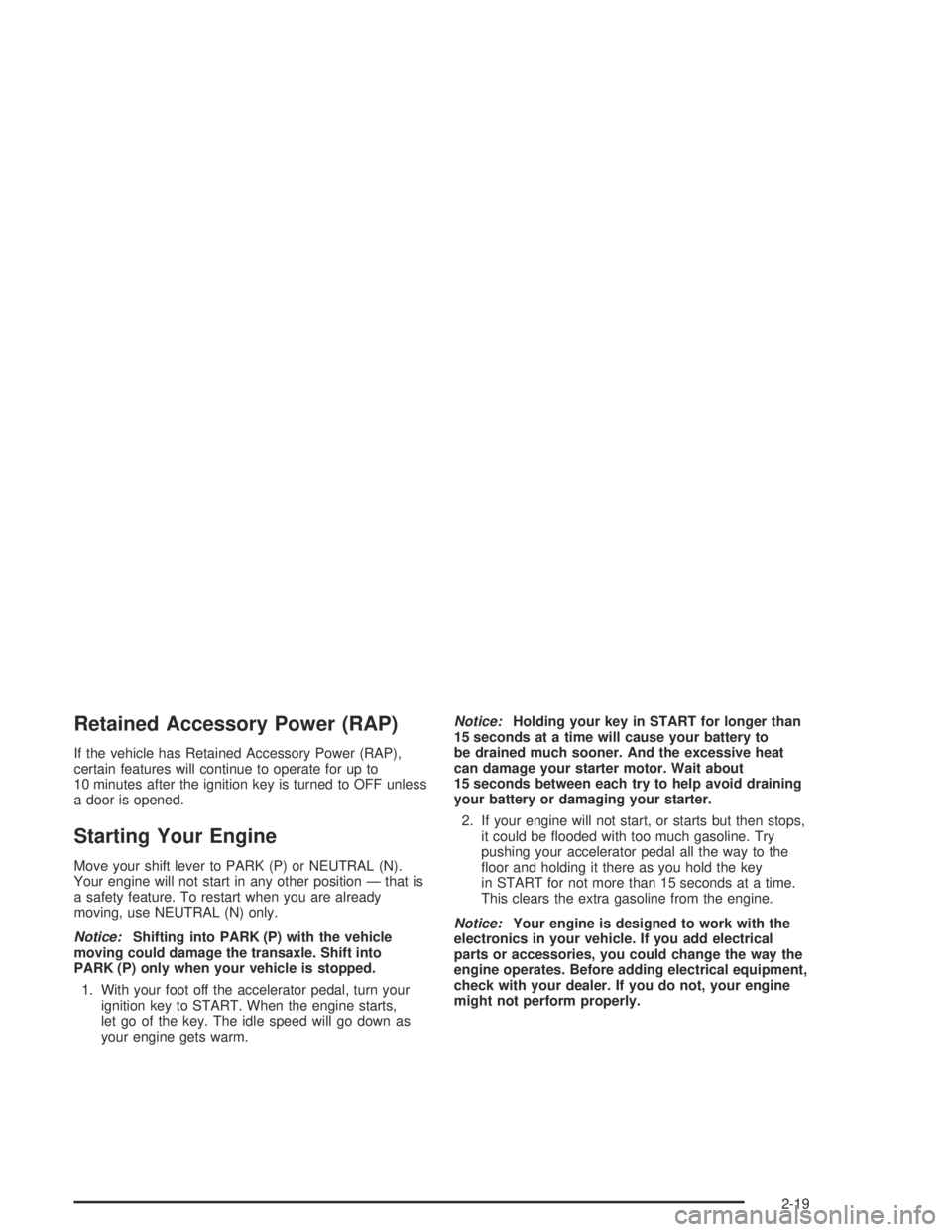
Retained Accessory Power (RAP)
If the vehicle has Retained Accessory Power (RAP),
certain features will continue to operate for up to
10 minutes after the ignition key is turned to OFF unless
a door is opened.
Starting Your Engine
Move your shift lever to PARK (P) or NEUTRAL (N).
Your engine will not start in any other position — that is
a safety feature. To restart when you are already
moving, use NEUTRAL (N) only.
Notice:Shifting into PARK (P) with the vehicle
moving could damage the transaxle. Shift into
PARK (P) only when your vehicle is stopped.
1. With your foot off the accelerator pedal, turn your
ignition key to START. When the engine starts,
let go of the key. The idle speed will go down as
your engine gets warm.Notice:Holding your key in START for longer than
15 seconds at a time will cause your battery to
be drained much sooner. And the excessive heat
can damage your starter motor. Wait about
15 seconds between each try to help avoid draining
your battery or damaging your starter.
2. If your engine will not start, or starts but then stops,
it could be �ooded with too much gasoline. Try
pushing your accelerator pedal all the way to the
�oor and holding it there as you hold the key
in START for not more than 15 seconds at a time.
This clears the extra gasoline from the engine.
Notice:Your engine is designed to work with the
electronics in your vehicle. If you add electrical
parts or accessories, you could change the way the
engine operates. Before adding electrical equipment,
check with your dealer. If you do not, your engine
might not perform properly.
2-19
Page 101 of 348
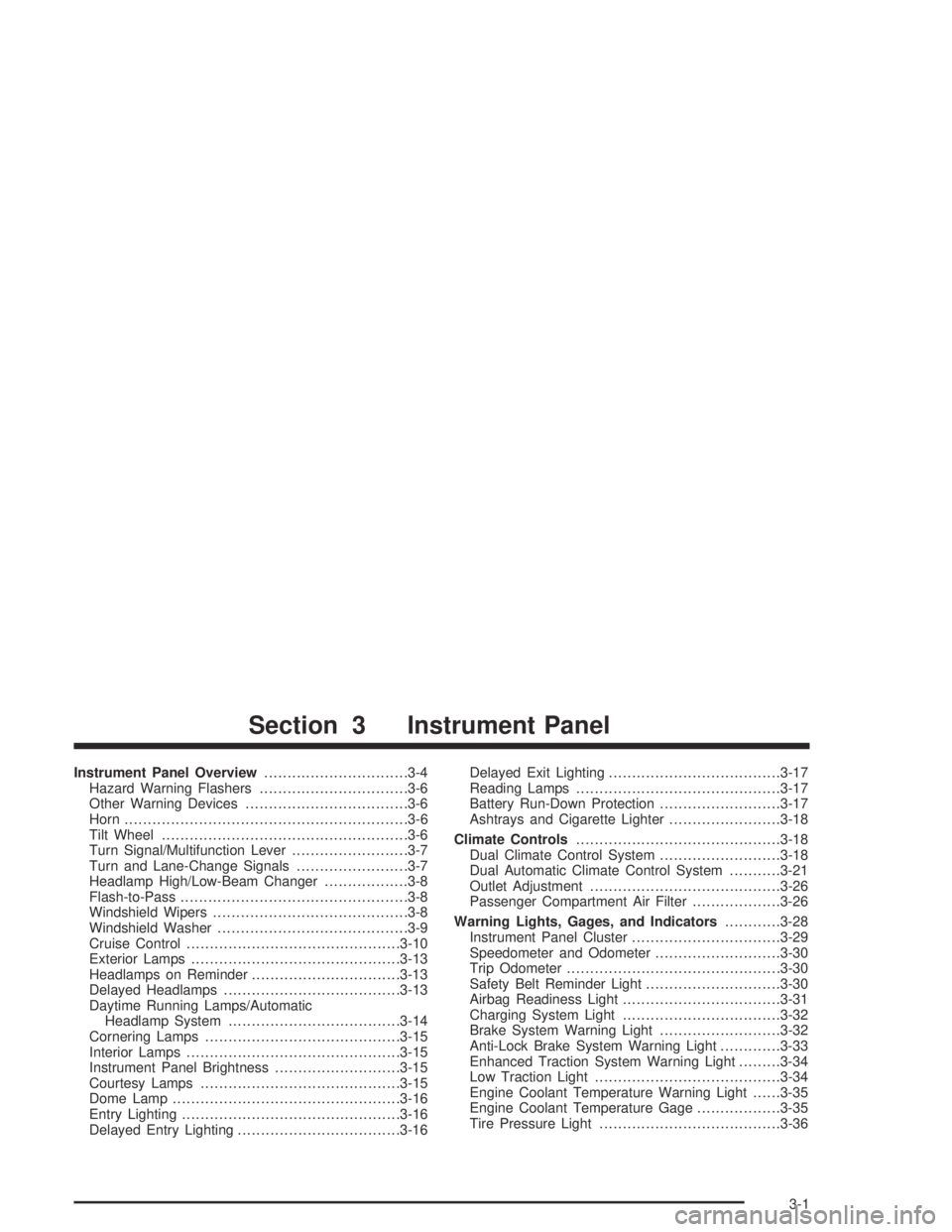
Instrument Panel Overview...............................3-4
Hazard Warning Flashers................................3-6
Other Warning Devices...................................3-6
Horn.............................................................3-6
Tilt Wheel.....................................................3-6
Turn Signal/Multifunction Lever.........................3-7
Turn and Lane-Change Signals........................3-7
Headlamp High/Low-Beam Changer..................3-8
Flash-to-Pass.................................................3-8
Windshield Wipers..........................................3-8
Windshield Washer.........................................3-9
Cruise Control..............................................3-10
Exterior Lamps.............................................3-13
Headlamps on Reminder................................3-13
Delayed Headlamps......................................3-13
Daytime Running Lamps/Automatic
Headlamp System.....................................3-14
Cornering Lamps..........................................3-15
Interior Lamps..............................................3-15
Instrument Panel Brightness...........................3-15
Courtesy Lamps...........................................3-15
Dome Lamp.................................................3-16
Entry Lighting...............................................3-16
Delayed Entry Lighting...................................3-16Delayed Exit Lighting.....................................3-17
Reading Lamps............................................3-17
Battery Run-Down Protection..........................3-17
Ashtrays and Cigarette Lighter........................3-18
Climate Controls............................................3-18
Dual Climate Control System..........................3-18
Dual Automatic Climate Control System...........3-21
Outlet Adjustment.........................................3-26
Passenger Compartment Air Filter...................3-26
Warning Lights, Gages, and Indicators............3-28
Instrument Panel Cluster................................3-29
Speedometer and Odometer...........................3-30
Trip Odometer..............................................3-30
Safety Belt Reminder Light.............................3-30
Airbag Readiness Light..................................3-31
Charging System Light..................................3-32
Brake System Warning Light..........................3-32
Anti-Lock Brake System Warning Light.............3-33
Enhanced Traction System Warning Light.........3-34
Low Traction Light........................................3-34
Engine Coolant Temperature Warning Light......3-35
Engine Coolant Temperature Gage..................3-35
Tire Pressure Light.......................................3-36
Section 3 Instrument Panel
3-1
Page 102 of 348
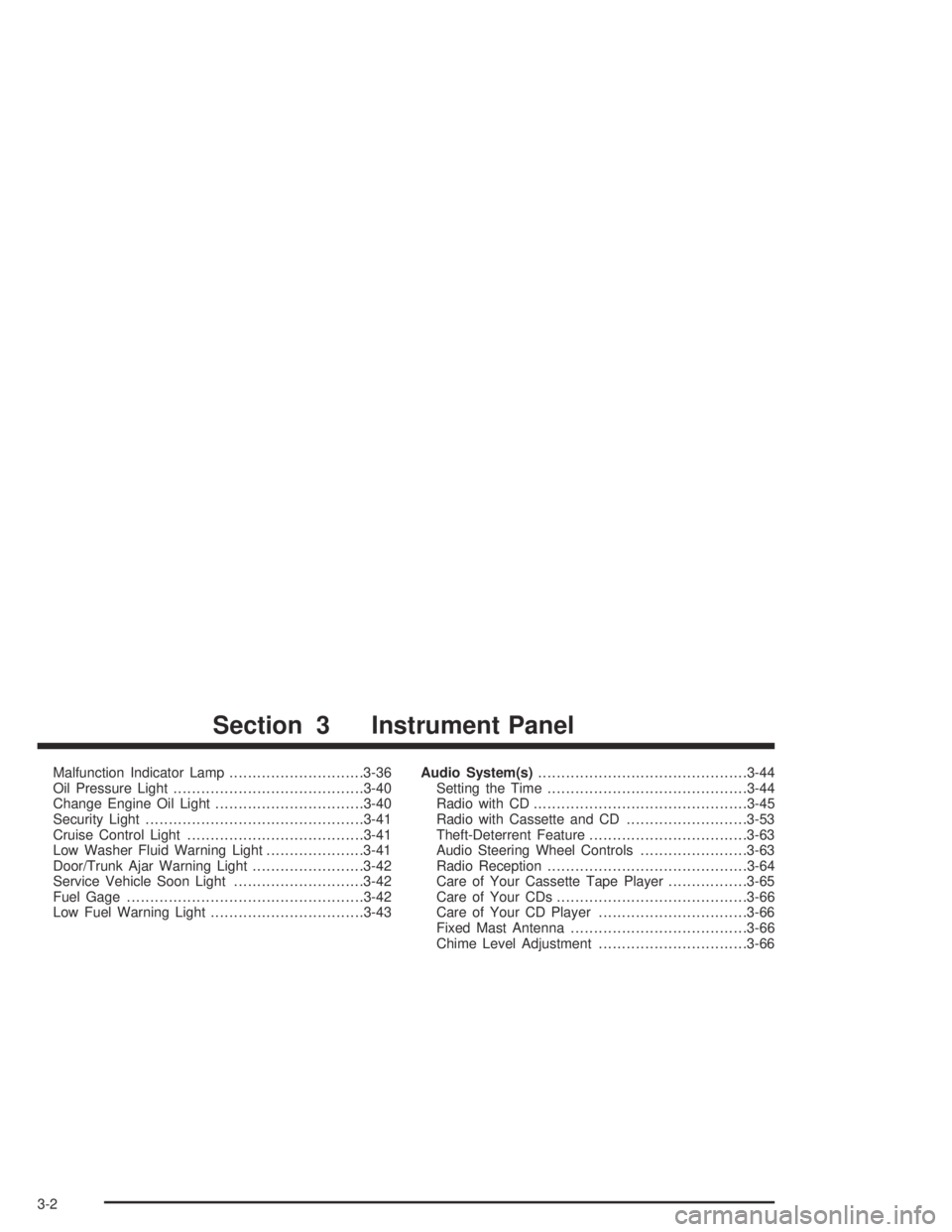
Malfunction Indicator Lamp.............................3-36
Oil Pressure Light.........................................3-40
Change Engine Oil Light................................3-40
Security Light...............................................3-41
Cruise Control Light......................................3-41
Low Washer Fluid Warning Light.....................3-41
Door/Trunk Ajar Warning Light........................3-42
Service Vehicle Soon Light............................3-42
Fuel Gage...................................................3-42
Low Fuel Warning Light.................................3-43Audio System(s).............................................3-44
Setting the Time...........................................3-44
Radio with CD..............................................3-45
Radio with Cassette and CD..........................3-53
Theft-Deterrent Feature..................................3-63
Audio Steering Wheel Controls.......................3-63
Radio Reception...........................................3-64
Care of Your Cassette Tape Player.................3-65
Care of Your CDs.........................................3-66
Care of Your CD Player................................3-66
Fixed Mast Antenna......................................3-66
Chime Level Adjustment................................3-66
Section 3 Instrument Panel
3-2
Page 114 of 348

4. Release the power door LOCK switch. These steps
must be carried out in a time period of less than
10 seconds, followed by a delay period of no more
than 10 seconds.
5. Then, press and hold the unlock position on the
power door switch. While holding the unlock
position, turn the exterior lamps control on and off
two times. Release the unlock position on the power
door switch. These operations must be carried
out in a time period of less than 10 seconds.
After releasing the unlock position on the power door
switch, a single chime will be heard if the delayed
headlamp illumination function has been turned off.
Two chimes will be heard if the feature has been turned
on. Disconnecting the vehicle’s battery for up to a
year will not change the programmed operation for
this feature.Daytime Running Lamps/Automatic
Headlamp System
Daytime Running Lamps (DRL) can make it easier for
others to see the front of the vehicle during the day.
DRL can be helpful in many different driving conditions,
but they can be especially helpful in the short periods
after dawn and before sunset. Daytime running lamps
are required to function at all times on all vehicles
�rst sold in Canada.
A light sensor on top of the instrument panel makes the
DRL work, so be sure it is not covered.
The DRL system will make the front turn signal lamps
come on when the following conditions are met:
The ignition is on.
The exterior lamps control is off.
The parking brake is released.
While the DRL are on, only the vehicle’s front turn
signal lamps will also be on. The headlamps,
taillamps, sidemarker and other lamps will not be on.
The instrument panel will not be lit up either.
3-14
Page 121 of 348
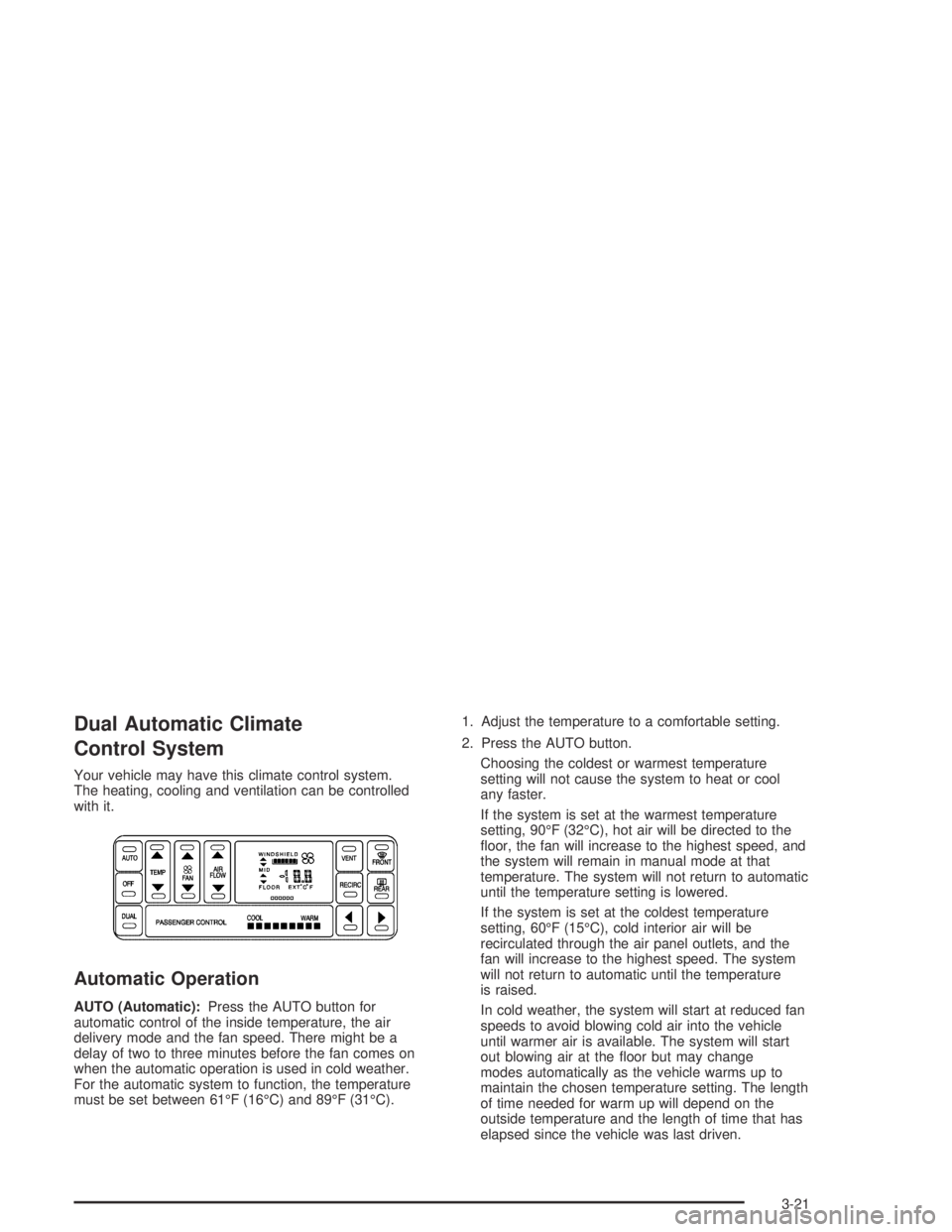
Dual Automatic Climate
Control System
Your vehicle may have this climate control system.
The heating, cooling and ventilation can be controlled
with it.
Automatic Operation
AUTO (Automatic):Press the AUTO button for
automatic control of the inside temperature, the air
delivery mode and the fan speed. There might be a
delay of two to three minutes before the fan comes on
when the automatic operation is used in cold weather.
For the automatic system to function, the temperature
must be set between 61°F (16°C) and 89°F (31°C).1. Adjust the temperature to a comfortable setting.
2. Press the AUTO button.
Choosing the coldest or warmest temperature
setting will not cause the system to heat or cool
any faster.
If the system is set at the warmest temperature
setting, 90°F (32°C), hot air will be directed to the
�oor, the fan will increase to the highest speed, and
the system will remain in manual mode at that
temperature. The system will not return to automatic
until the temperature setting is lowered.
If the system is set at the coldest temperature
setting, 60°F (15°C), cold interior air will be
recirculated through the air panel outlets, and the
fan will increase to the highest speed. The system
will not return to automatic until the temperature
is raised.
In cold weather, the system will start at reduced fan
speeds to avoid blowing cold air into the vehicle
until warmer air is available. The system will start
out blowing air at the �oor but may change
modes automatically as the vehicle warms up to
maintain the chosen temperature setting. The length
of time needed for warm up will depend on the
outside temperature and the length of time that has
elapsed since the vehicle was last driven.
3-21